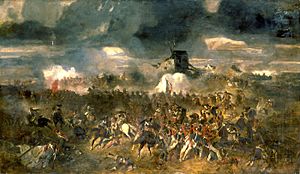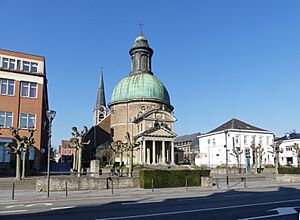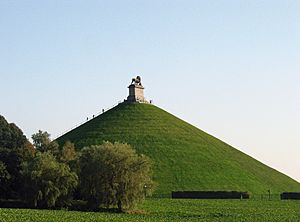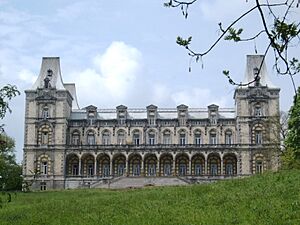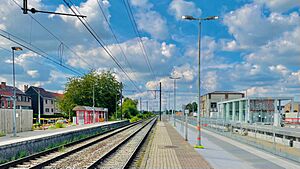Waterloo, Belgium facts for kids
Quick facts for kids
Waterloo
|
|||
|---|---|---|---|
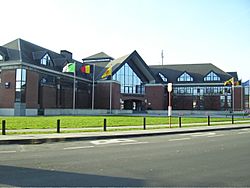
Maison communale (city hall) of Waterloo
|
|||
|
|||
| Country | Belgium | ||
| Region | Wallonia | ||
| Community | French Community | ||
| Province | Walloon Brabant | ||
| Arrondissement | Nivelles | ||
| Area | |||
| • Total | 21.03 km2 (8.12 sq mi) | ||
| Population
(January 2010)
|
|||
| • Total | 29,598 | ||
| • Density | 1,407.4/km2 (3,645.2/sq mi) | ||
| Postal codes |
1410
|
||
| Area codes | 02 | ||
Waterloo is a town in Wallonia, a region in Belgium. It is located in the province of Walloon Brabant. In 2011, about 29,700 people lived there. The town covers an area of about 21 square kilometers.
Waterloo is just south of Brussels, the capital city of Belgium. It is also very close to the town of Braine-l'Alleud. Waterloo is most famous for the Battle of Waterloo, which happened in 1815. In this battle, Napoleon Bonaparte was finally defeated.
Contents
What Does the Name Waterloo Mean?
The name Waterloo comes from an old Dutch language. It combines two words: "water" (meaning water or watery) and "loo." "Loo" means a forest, a clearing in a forest, or a wet, marshy area.
A Brief History of Waterloo
The name Waterloo first appeared in records in 1102. Back then, it was a small village near what is now the Sonian Forest. It was located along an important road that connected Brussels to a coal mine in the south.
Waterloo was a good resting spot for travelers and merchants. They often carried coal and needed a safe place to stop. It also offered protection from bandits.
The area where Waterloo is located became part of the Duchy of Brabant in 1183. Brussels became the capital of this Duchy in 1267.
Waterloo began to grow more in the 1600s. A royal chapel was built in 1687. This chapel later became the Church of Saint Joseph of Waterloo.
In the late 1700s, the French invaded the region. This changed how the area was governed. Before 1796, Waterloo was split into two parts: Grand-Waterloo and Petit-Waterloo. The French created the single municipality of Waterloo.
Over the years, Waterloo continued to grow. More land was added to the municipality in 1813 and 1824. In 1801, Waterloo had about 1,571 people. By 1846, its population had doubled to 3,202.
In 1995, the province of Brabant was divided. Waterloo became part of the new province of Walloon Brabant.
The Famous Battle of Waterloo
The Battle of Waterloo happened near Waterloo on June 18, 1815. It was a huge battle between the French army, led by Napoleon Bonaparte, and a group of allied armies.
These allied armies were from countries like Prussia, the United Kingdom, the Netherlands, and others. Their main commanders were the Duke of Wellington and Field Marshal von Blücher. This battle was a major event in European history.
Areas Within Waterloo
Waterloo is divided into six main areas, or districts:
- Faubourg Ouest (north-west)
- Faubourg Est (north-east)
- Chenois (west of the railway)
- Centre (the main part of town)
- Joli-Bois (south of the center)
- Mont-St-Jean (north of the battlefield)
Who Lives in Waterloo?
Waterloo has a diverse population. Almost one-fifth of the people living there are not Belgian. Many of these residents work for international organizations or companies in Brussels.
The most common non-Belgian groups are French, Italian, British, American, and Swedish. Waterloo is also known as one of the wealthiest towns in the Wallonia region.
Waterloo's Economy
Waterloo is an important business center. It is home to the European headquarters of Mastercard. You can also find a large Carrefour supermarket and a Delhaize store there. There are also many banks and office buildings.
A street with many shops, called Petit Paris, is located on the Chaussée de Bruxelles. This street is a popular shopping area.
Learning in Waterloo
Waterloo has several international and local schools. The Argenteuil estate is home to many of them, including:
- The Scandinavian School of Brussels
- The European School of Bruxelles-Argenteuil
- "Den norske skolen i Brussel" (The Norwegian School in Brussels)
- The Queen Elisabeth Music Chapel
St. John's International School is also located in Waterloo.
Famous Places to Visit
Lion's Mound
The Lion's Mound is a large monument built to remember those who died in the 1815 Battle of Waterloo. It stands on the spot where William II of the Netherlands was hit by a musket ball during the battle.
At the top of the mound, there is a large statue of a lion looking towards France. Visitors can climb 226 steps to the top. From there, you get an amazing view of the entire battlefield.
Other places related to the battle nearby include:
- The Battle Panorama Mural
- The Wellington Museum
- The Church of St. Joseph, where the Duke of Wellington is said to have prayed before the battle.
Argenteuil Estate
The Argenteuil estate is a large area of land in the Sonian Forest. It was bought in 1831 by Ferdinand De Meeus, a Belgian noble. He named it "Argenteuil."
The first Château d'Argenteuil (a large country house) was built in 1835. It burned down in 1847 but was rebuilt. Later, another grand house, the Château Bellevue, was built on the estate.
Château d'Argenteuil
In 1940, the Château d'Argenteuil was sold to a group of Carmelite Sisters. However, the building was not right for them, so they moved out. The Belgian government bought the château in 1949.
It was used for various schools over the years. In 1990, the Scandinavian School of Brussels bought the château and its grounds. Since 2016, the European School of Bruxelles-Argenteuil also operates on the same site.
Château Bellevue
The Belgian government also bought the Château Bellevue in 1949. It was used as a residence for important visitors during the 1958 World's Fair in Brussels.
From 1961, it became the official home of King Leopold III and his wife, Princess Lilian of Belgium. The Belgian government later sold the Château Bellevue in 2004.
Public Transportation
The Waterloo railway station opened on February 1, 1874. This allowed people to travel by train between Waterloo and Brussels. The line was later extended south to Nivelles and Luttre.
Today, local trains serve Waterloo. You can catch at least one train every hour in each direction. During busy times, there are also direct trains between Waterloo and Brussels.
Sports in Waterloo
Waterloo is home to successful sports teams.
- ASUB Waterloo is one of Belgium's most successful Rugby Union teams.
- Watducks Hockey Club is a very strong field hockey team. They have won many Belgian championships and even a European championship in 2019.
Well-Known People from Waterloo
- In 1959, Jeannine Deckers, who became famous as The Singing Nun, lived in Waterloo.
- In 2018, former Catalonia president Carles Puigdemont moved to Waterloo.
Waterloo's International Connections
Waterloo has "twin town" or "sister city" relationships with several other towns around the world. This helps promote cultural exchange and friendship.
 Nagakute, Aichi, Japan
Nagakute, Aichi, Japan Sekigahara, Gifu, Japan
Sekigahara, Gifu, Japan Rambouillet, France
Rambouillet, France Waterloo, Ontario, Canada
Waterloo, Ontario, Canada Differdange, Luxembourg
Differdange, Luxembourg
See also
 In Spanish: Waterloo (Bélgica) para niños
In Spanish: Waterloo (Bélgica) para niños




